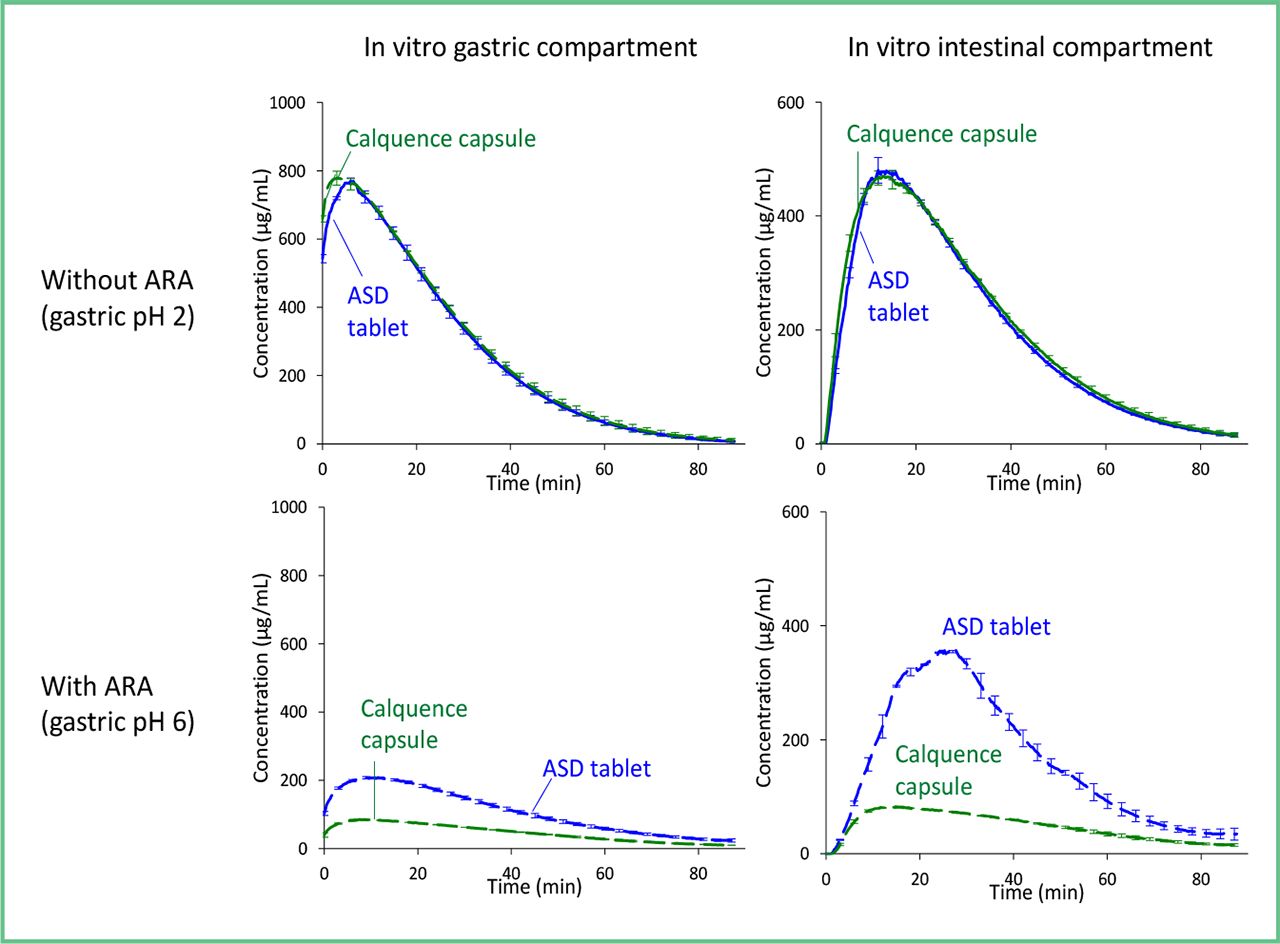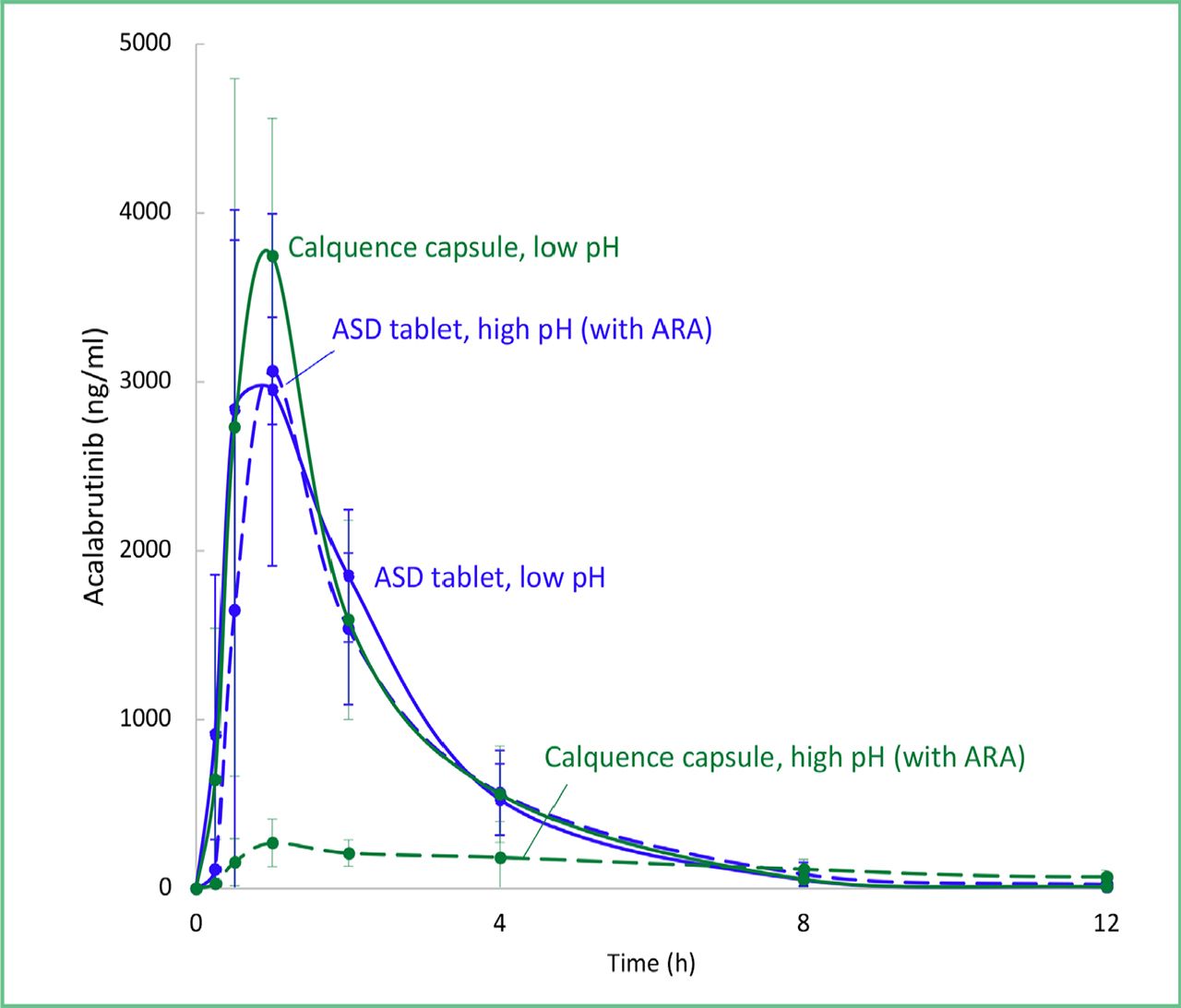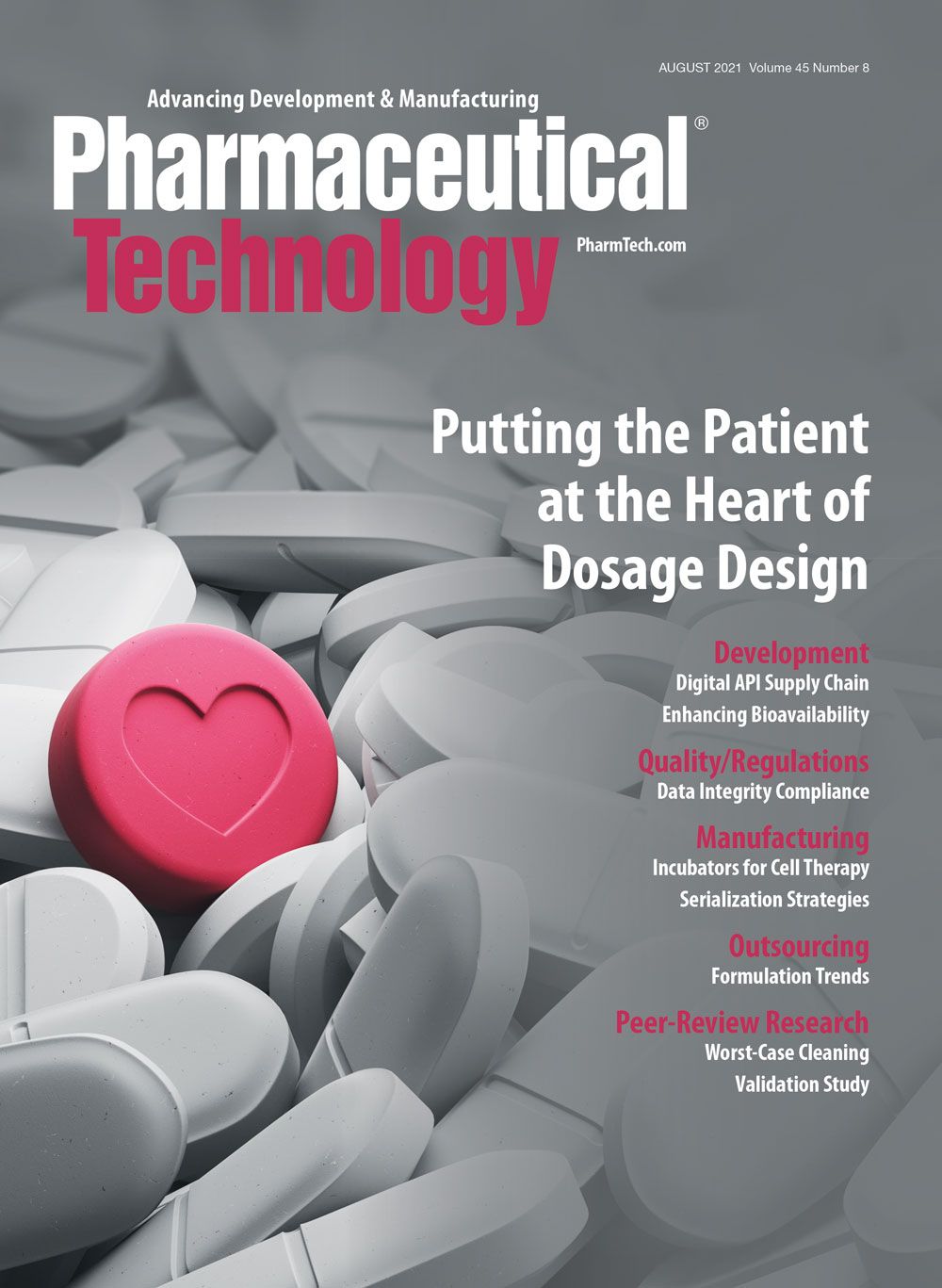Further Reading
Learn more by reading recent research on amorphous solid dispersions.
Amorphous solid dispersions can overcome the pH effect encountered with oral oncology medications.
PAKETESAMA - STOCK.ADOBE.COM

Oral delivery is the preferred route of drug product administration for maximizing patient compliance and lowering costs. However, successful oral delivery can be challenging for poorly water soluble drugs that resist dissolving in gastrointestinal (GI) fluids. Formulating drugs as amorphous solid dispersions (ASDs) can increase drug solubility, thereby enhancing drug product dissolution in GI fluids and maximizing the amount of drug that reaches the bloodstream (1). By increasing the drug in the bloodstream (i.e., enhancing oral bioavailability), ASD dosage forms can enable effective oral delivery and increase patient safety, efficacy, and compliance.
ASDs can improve crystalline drug products in many ways, including by removing food–drug and drug–drug interactions (DDIs), decreasing dose, and reducing variability in plasma exposure (2). While these benefits can be realized across therapeutic areas, oncology is particularly relevant as it accounts for 25% of drugs approved by FDA in the last decade, and many oncology drugs are poorly water soluble across at least part of the GI pH range (3,4). Poor oral bioavailability in oncology is common, often manifesting as food–drug interactions, variation in exposure, and DDIs (5). Numerous marketed weak base, oral oncology drugs show decreased absorption as a result of high gastric pH when taken with acid reducing agents (ARAs) (6,7).
Calquence (crystalline acalabrutinib) is an example of a commercially marketed oncology drug that could benefit from bioavailability enhancement using ASDs (8). Acalabrutinib is a weak base with poor solubility at high gastric pH, resulting in clinically significant DDIs with ARAs. When administered with the proton pump inhibitor (PPI), omeprazole, the area under the plasma drug concentration–time curve (AUC) decreased by 43% in healthy volunteers (9). To prevent this issue, patients must avoid coadministration with PPIs and stagger dosing with histamine type 2 (H2) receptor antagonists (H2RAs) and antacids (9). Because ARAs are commonly taken by oncology patients, this DDI can reduce efficacy and patient compliance because of the complex dosing schedules required (10).
Learn more by reading recent research on amorphous solid dispersions.
ASDs can improve outcomes for patients taking Calquence (acalabrutinib) by increasing acalabrutinib bioavailability at high gastric pH, thereby removing the DDI with ARAs. This article describes development of an ASD tablet that removed the acalabrutinib pH effect and outperformed Calquence 2.4-fold in the presence of the ARA, famotidine, at the human-prescribed (100 mg) dose in beagle dogs (11). ASD tablets were 60% smaller than Calquence and achieved good stability and manufacturability. These results have positive implications for using ASDs to solve bioavailability challenges, particularly for weak base drugs, which make up 78% of new molecular entities approved between 2003 and 2013 that showed clinical DDIs with ARAs (12).
Designing tablets to overcome the Calquence ARA effect required an understanding of acalabrutinib’s physicochemical properties and the mechanism of reduced performance of crystalline acalabrutinib when taken with ARAs. Acalabrutinib is a Biopharmaceutics Classification System (BCS) Class II drug with low intrinsic solubility and moderate log P (8). The drug is a weak base (pKa values = 3.5 and 5.8) causing it to become ionized at low pH, resulting in moderately high solubility in the stomach of fasted humans (pH ~1–3) (13). However, as gastric pH increases with ARA administration (pH ~3–7) acalabrutinib is largely non-ionized and solubility is reduced, resulting in decreased dissolution, which decreases absorption across the intestinal membrane and increases the extent of dose metabolized in humans (8,14–17). Therefore, an immediate-release ASD tablet was designed that maintained high dissolved acalabrutinib concentrations at both high and low gastric pH during in-vitro dissolution testing. In this case, high concentrations were defined as being at or above the value achieved with Calquence at low gastric pH (i.e., as prescribed). In addition, ASD tablets were designed to achieve good physical and chemical stability, good manufacturability, and to minimize size.
ASDs contain amorphous drug molecularly dispersed in a polymer matrix, which is used to stabilize the amorphous form during storage and in GI fluids (18). The acalabrutinib ASD consisted of 50/50 (% w/w) acalabrutinib/hydroxypropyl methylcellulose acetate succinate (HPMCAS-H) (Aqoat, Shin-Etsu Chemical Co., Ltd., Tokyo, Japan). HPMCAS is an ideal polymer for ASDs as a result of its high glass transition temperature and low hygroscopicity, facilitating high ASD physical stability during storage, and its amphiphilicity, promoting favorable interactions with hydrophobic drugs and intestinal fluids to inhibit crystallization in the GI tract (11,19).
The ASD was manufactured in a customized, laboratory-scale spray dryer and secondary dried in a vacuum dryer with high yield (97%) and low residual spray solvent (100 ppm methanol). In the spray drying process, drug and polymer are dissolved in an organic solvent and sprayed through an atomizer nozzle to create small droplets. At the same time, a drying gas is pumped into the spray dryer to rapidly evaporate solvent and lock the drug and polymer into a homogeneous amorphous solid dispersion. The resulting ASD particles are separated from the gas stream and collected for processing into a final dosage form (20). Spray drying is a scalable process precedented in commercial manufacturing of ASDs (21).
ASD was confirmed to be amorphous and homogenous using powder X-ray diffraction (PXRD) and modulated differential scanning calorimetry (mDSC), with a lack of surface crystals using scanning electron microscopy (SEM) (11). In addition, the ASD was confirmed to remain amorphous and homogenous after open storage for six months at accelerated temperature and relative humidity (40 °C/75% RH) as measured by PXRD, mDSC, and SEM, indicating good ASD physical stability and a good outlook for storage at ambient or refrigerated conditions over a typical product shelf life (i.e., two years) (11).
ASD was dry granulated with excipients and compressed into tablets using a small-scale manufacturing process. ASD tablets had a 100-mg unit dosage strength, a 25 wt% drug loading, and a 60% smaller volume than Calquence capsules (11). ASD tablets were found to be chemically stable when stored at room temperature with desiccant or in the refrigerator, which are acceptable storage conditions for pharmaceutical drug products (11).
Effective development of ASD dosage forms requires use of biopredictive in-vitro dissolution methods to evaluate drug formulation performance under varying GI conditions (22). In this study a custom, controlled-transfer dissolution (CTD) apparatus containing simulated gastric and intestinal compartments was selected to study dissolution performance of the ASD tablet and commercial Calquence capsule (11,23). Testing was conducted prior to the in-vivo study in conditions representative of fasted beagle dogs treated with either pentagastrin or famotidine to lower or raise gastric pH, respectively. Simulated gastric fluid comprised hydrochloric acid adjusted to pH 2 or 6, and simulated intestinal fluid consisted of pH 6.5 phosphate buffer containing bile salts and phospholipids (i.e., FaSSIF powder, Biorelevant.com Ltd. [London, UK]) at levels characteristic of fasted beagle dogs (average of 6.7 mM) (11). Dosage forms were added to the gastric compartment of the CTD, and fiber-optic ultraviolet probes were used to monitor acalabrutinib concentrations in the gastric and intestinal compartments with time as gastric contents transited to the intestinal compartment at a physiological gastric emptying rate (15-min mono-exponential half-life).
As shown in Figure 1, the ASD tablet and Calquence capsule achieved similar concentration–time profiles at low gastric pH (pH = 2) due to the high solubility of both crystalline and amorphous acalabrutinib. Both dosage forms reached high drug concentrations in the gastric compartment and supersaturated in the intestinal compartment for the duration of the experiment. However, at elevated gastric pH simulating fasted beagle dogs taking an ARA (pH = 6), the ASD tablet outperformed Calquence due to the higher solubility of amorphous acalabrutinib. At elevated gastric pH the ASD tablet reached higher maximum concentrations and a 3.4-fold higher average AUC in the intestinal compartment than Calquence. Whereas the ASD tablet achieved supersaturated drug concentrations in both compartments, the Calquence capsule was solubility-limited and did not achieve supersaturated drug concentrations. The ASD tablet mitigated the ARA effect in vitro, where average AUC in the intestinal compartment at elevated gastric pH is 83% of that at low gastric pH.
Figure 1: Acalabrutinib concentration time profiles in the in-vitro controlled transfer dissolution (CTD) test for amorphous solid dispersion (ASD) tablet and commercial Calquence capsule at gastric pH 2, ‘without acid reducing agent (ARA)’ (top) and gastric pH 6, ‘with ARA’ (bottom) (11). [FIGURES ARE COURTESY OF THE AUTHOR]

Beagle dogs are a commonly used species for testing dosage form performance prior to clinical testing in humans. To demonstrate mitigation of the Calquence ARA effect in vivo, ASD tablets and commercial Calquence capsules were administered to beagle dogs in a crossover study at the human prescribed 100-mg dose in compliance with the Animal Welfare Act Regulations (9 Code of Federal Regulation 3). To study performance in the absence of an ARA, six dogs were given a subcutaneous injection of pentagastrin to lower gastric pH; whereas to determine performance in the presence of an ARA, the same dogs were treated with oral famotidine to increase gastric pH (24,25). Blood was collected for up to 24 hours after dosing, and acalabrutinib plasma concentrations were determined by liquid chromatography–tandem mass spectrometry (11).
Figure 2: Acalabrutinib plasma concentration time profiles in fasted beagle dogs for amorphous solid dispersion (ASD) tablets and commercial Calquence capsules at low gastric pH (without acid reducing agent [ARA], treated with 6 mg/kg subcutaneous pentagastrin) and high gastric pH (with ARA, treated with 40 mg oral famotidine) (7 day washout between phases, n=6) (11).

As shown in Figure 2 and Table I, ASD tablets achieved similar concentration–time profiles and AUC at low and high gastric pH conditions and matched performance of Calquence at low gastric pH conditions. Whereas, Calquence capsules demonstrated an ARA effect, achieving only 37% of the average AUC achieved at low gastric pH conditions. At high gastric pH conditions, ASD tablets outperformed Calquence capsules, with a 2.4-fold higher average AUC. These results show that ASD tablets overcame the ARA effect and achieved performance (e.g., average AUC) of Calquence as prescribed (11). Furthermore, in-vivo results were in line with in-vitro dissolution testing in the CTD apparatus, which predicted similar performance of the ASD tablet and Calquence at low gastric pH, ability of the ASD tablet to mitigate the ARA effect, and superior performance of the ASD tablet to the Calquence capsule at high gastric pH.
Table I. Acalabrutinib under the plasma drug concentration–time curve (AUC) from time zero extrapolated to infinity for amorphous solid dispersion (ASD) tablets and commercial Calquence capsules at low gastric pH (without acid reducing agent [ARA], treated with 6 mg/kg subcutaneous pentagastrin) and high gastric pH (with ARA, treated with 40 mg oral famotidine) (7 day washout between phases, n=6) (11).

ASD tablets were shown to overcome the ARA (i.e., pH) effect observed with the oral oncology medication, Calquence, at a 60% smaller dosage unit size in fasted beagle dogs. Whereas ASD tablets achieved similar average AUC in dogs under low and high gastric pH conditions, Calquence capsules achieved a 63% lower,
statistically different, average AUC in dogs under high gastric pH conditions (i.e., in the presence of an ARA). This outcome suggests that ASD tablets are a promising alternative to Calquence for improving patient convenience, compliance, and efficacy. Not only could ASD tablets allow patients to take acalabrutinib with or without highly prescribed ARAs, but ASD tablets promote swallowability due to their smaller size. Further, ASD and ASD tablets showed promise in attaining a long product shelf life and achieved good manufacturability using scalable spray drying and tableting processes, indicating potential to become a robust commercial drug product.
ASD dosage forms can improve efficacy, convenience, and compliance for patients taking a variety of poorly water-soluble medicines by increasing solubility and improving oral bioavailability. Like Calquence, many oral oncology and weakly basic drugs show clinical DDIs with ARAs, a challenge that can be overcome by using ASDs to improve drug solubility at high pH (3,12). Additional difficulties prevalent in oral oncology include variation in plasma exposure and food–drug interactions (5). As with the ARA problem statement, these challenges can be solved with ASDs when poor solubility is to blame. Knowledge of drug product and physiological properties combined with in-vitro and in-silico tools can be used to determine which drugs can benefit from ASDs, and to design robust ASD drug products. Trends in oral oncology and favorable results of ASD development indicate that ASDs are ripe with potential for creating new, effective oral medicines and improving medicines already on the market.
1. G. Van den Mooter, Drug Discov. Today Technol., 9 (2) e79–e85 (2012).
2. U.H. Gala, D.A. Miller, and R.O. Williams, Biochim. Biophys. Acta Rev. Cancer, 1873 (1) 188319 (2020).
3. D.G. Brown and H.J. Wobst, J. Med. Chem., 64 (5) 2312–2338 (2021).
4. E. Sawicki, et al., Cancer Treat. Rev., 50, 247–263 (2016).
5. M. Herbrink, et al., Cancer Treat. Rev., 41, 412–422 (2015).
6. A.A.T. Uchiyama, et al., Curr. Oncol., 28 (1) 783–799 (2021).
7. R.W. van Leeuwen, et al., Lancet Oncol., 15 (10) e315–326 (2014).
8. X.J.H. Pepin, et al., Eur. J. Pharm. Biopharm., 142, 435–448 (2019).
9. FDA, Calquence FDA Label, www.fda.gov, November 2019.
10. G.S. Smelick, et al., Mol. Pharmaceutics, 10 (11) 4055–4062 (2013).
11. D.M. Mudie, et al., Pharmaceutics, 13 (4) 557 (2021).
12. D. Patel, et al., Clin. Pharmacokinet., 59 (4) 447–462 (2020).
13. C.A. Bergström, et al., Eur. J. Pharm. Sci., 57, 173–199 (2014).
14. L. Zhang, et al., Clin. Pharmacol. Ther., 96 (2) 266–277 (2014).
15. C. Litou, et al., Pharm. Res., 33 (6) 1399-1412 (2016).
16. P.J. Prichard, et al., Gastroenterology, 88 (1 Pt 1) 64–69 (1985).
17. R. Tutuian, et al., Aliment. Pharmacol. Ther., 16 (4) 829–836 (2002).
18. S. Baghel, H. Cathcart, and N.J. O’Reilly, J. Pharm. Sci., 105 (9) 2527–2544 (2016).
19. D.T. Friesen, et al., Mol. Pharm., 5 (6) 1003–1019 (2008).
20. A. Paudel, et al., Int. J. Pharm., 453 (1) 253–284 (2013).
21. N. Wyttenbach and M. Kuentz, Eur. J. Pharm. Biopharm., 112, 204–208 (2017).
22. D.M. Mudie, et al., AAPS J, 22 (2) 34 (2020).
23. D.M. Mudie, et al., Mol. Pharm., 17 (12) 4463–4472 (2020).
24. R.M. Fancher, et al., J. Pharm. Sci., 100 (7) 2979–2988 (2011).
25. P. Zane, et al., Eur. J. Pharm. Sci., 57, 207–213 (2014).
Deanna Mudie, PhD, is principal scientist, Lonza, Bend, OR, USA.
Pharmaceutical Technology
Vol. 45, No. 8
August 2021
Pages: 24–28
When referring to this article, please cite it as F. Thomas, “In-Vivo Demonstration of Enhanced Bioavailability of Acalabrutinib ASD Tablets,” Pharmaceutical Technology 45 (8) 2021.

Drug Solutions Podcast: A Closer Look at mRNA in Oncology and Vaccines
April 30th 2024In this episode fo the Drug Solutions Podcast, etherna’s vice-president of Technology and Innovation, Stefaan De Koker, discusses the merits and challenges of using mRNA as the foundation for therapeutics in oncology as well as for vaccines.
Drug Solutions Podcast: Applying Appropriate Analytics to Drug Development
March 26th 2024In this episode of the Drug Solutions Podcast, Jan Bekker, Vice President of Business Development, Commercial and Technical Operations at BioCina, discusses the latest analytical tools and their applications in the drug development market.
INTERPHEX 2025: Use of Walk-In Chambers for Bio/Pharma Development and Manufacturing
April 2nd 2025Sitting down with the PharmTech Group at INTERPHEX 2025, Christopher Murphy, director of Global Business Development and Service Customer Support at Environmental Specialties, discusses the design and critical role of walk-in chambers in the bio/pharmaceutical industry.